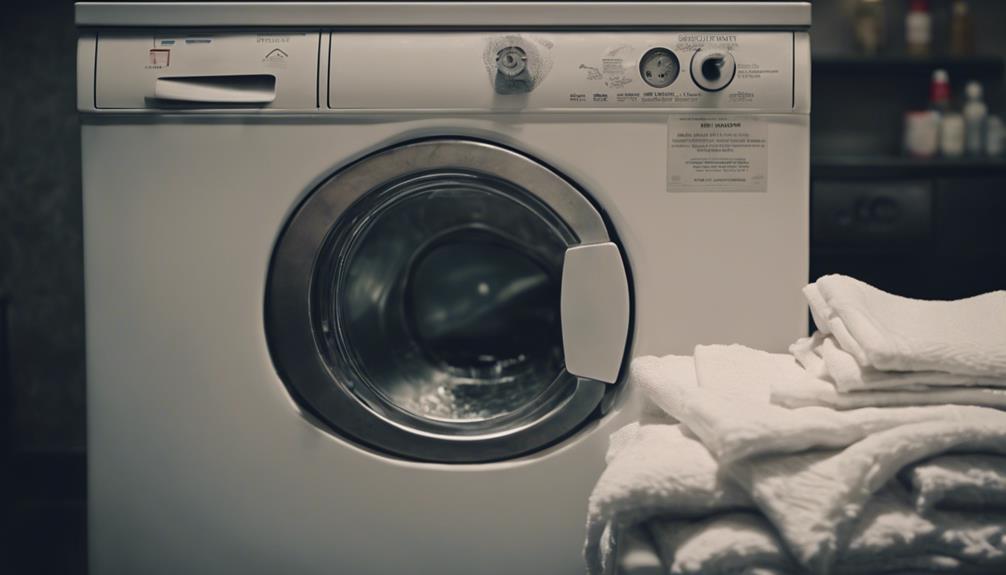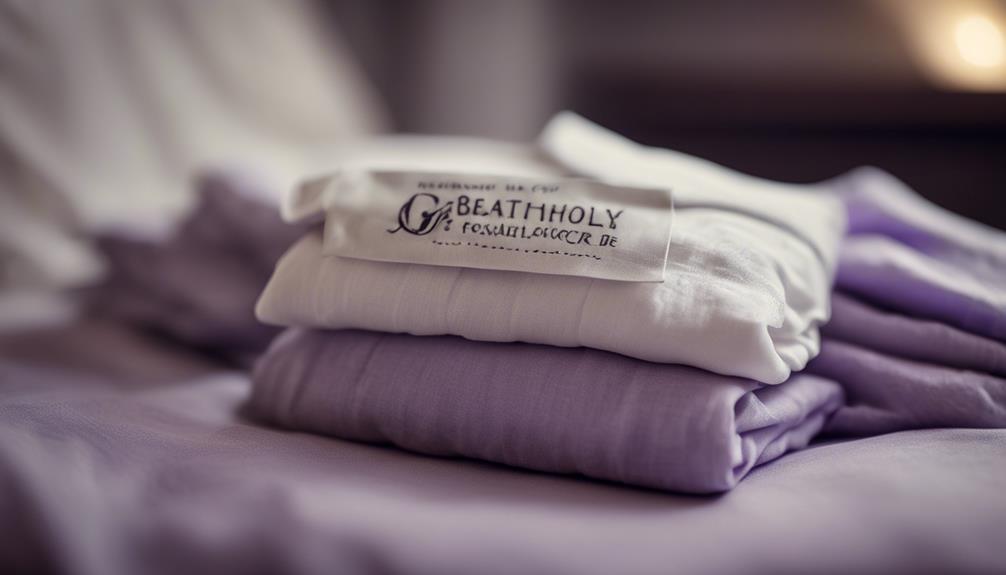To wash your bed linens effectively, follow care label instructions, pre-treat stains, adjust washing frequency, evenly load the machine, choose suitable detergent and water temps, dry properly, and store correctly. These steps maintain cleanliness, durability, and comfort levels.
Care Label Instructions
When washing bed linens, always follow the care label instructions provided on the fabric for the best results. The care label offers vital information such as water temperature, detergent type, and drying methods tailored to the specific fabric type of your sheets.
Different fabrics like cotton, silk, linen, and polyester may have distinct washing guidelines to maintain their quality. By adhering to these instructions, especially using the recommended water temperature and detergent type, you guarantee that your sheets are cleaned effectively without causing any damage. Opting for a gentle cycle is often recommended for most fabrics to prevent wear and tear.
After washing, make sure to dry the sheets according to the care label instructions to prolong their lifespan. Ignoring these guidelines can lead to issues like shrinkage, color fading, and reduced longevity of your bed linens, so it's crucial to follow the care label meticulously.
Stain Treatment Before Washing
To effectively remove stains from your bed linens before washing, consider pre-treating them with specific stain removers or solutions. Different types of stains require different treatments. For protein-based stains like blood, sweat, or food, use enzyme-based stain removers.
Fresh stains can be treated with a paste of baking soda and water before laundering your sheets. In the case of oily stains on your bed linens, sprinkle cornstarch or talcum powder on the affected area to absorb the oil before washing.
It's important to avoid using hot water on stains like blood or protein-based spills, as this can set the stain and make it harder to remove. Always refer to the care label on your bed linens for specific instructions on stain removal to make sure you're taking the best approach to keep your sheets clean and fresh.
Frequency of Washing

You might be wondering how often you should wash your bed linens for best cleanliness and hygiene. The frequency of washing your sheets and pillowcases plays an important role in maintaining a healthy sleeping environment.
Let's explore the recommended washing schedule to make sure your bed linens stay fresh and free from dirt, allergens, and bacteria.
Washing Schedule
Maintaining a regular washing schedule for your bed linens is essential to ensuring cleanliness and hygiene in your sleeping environment. It's recommended to wash your bed linens every 1-2 weeks to eliminate dirt, oils, and allergens.
For those with allergies or sensitive skin, consider increasing the washing frequency to weekly to help alleviate symptoms. Changing and washing pillowcases more frequently can also assist in managing skin problems.
During periods of illnesses or infestations, it's best to change and wash your bed linens daily to prevent the spread of germs and maintain a hygienic sleeping space.
Bed Linen Hygiene
Regular washing of bed linens every 1-2 weeks is vital for maintaining proper hygiene and cleanliness in your sleeping environment. Weekly washing helps remove sweat, skin oils, and dirt, promoting better bed linen hygiene.
Individuals with dust mite allergies benefit from more frequent washing to reduce allergen exposure. Changing and washing pillowcases regularly can aid in managing skin problems like acne.
During illnesses or infestations, consider daily changes and washes to uphold cleanliness standards. Tailoring washing frequency to personal factors such as sweating during sleep and overall hygiene preferences is essential.
Proper Loading and Washing Techniques
When loading your bed linens into the washer, make sure to distribute them evenly to avoid tangling.
Select the appropriate wash cycle and settings for the specific fabric of your linens to maintain their quality.
Checking the care label for washing instructions is essential to prevent any damage during the cleaning process.
Sorting by Color
To maintain the vibrancy of your bed linens, always sort them by color before loading them into the washing machine. Here are some reasons why color sorting is essential for preserving the quality and appearance of your bedding:
- Prevent color bleeding and fabric dullness
- Maintain the vibrancy of light and dark linens
- Extend the lifespan of your linens by following proper sorting techniques
Using Mild Detergent
After sorting your bed linens by color to maintain their vibrancy, the next step is to make sure you use a mild detergent and follow proper loading and washing techniques for best cleaning results.
Using a mild detergent, as recommended on the care label, helps prevent damage to your bed linens. Select the appropriate water temperature and cycle settings based on the fabric type to guarantee effective washing.
Avoid overloading the washing machine to allow the bed linens to move freely and get thoroughly cleaned. Following the instructions on the care label is essential for effective washing and to prevent any potential damage to your bed linens.
Suitable Detergent and Water Temperature

For best cleaning results and fabric maintenance, choose a high-quality detergent suitable for your bed linens and match it with the appropriate water temperature based on the fabric type. When washing your bed linens, using a high-quality detergent is essential to guarantee gentle care for delicate fibers and to preserve the vibrant colors of your linens. Selecting the right water temperature is equally important; opt for hot water when washing cotton linens to remove tough stains effectively, while choosing warm or cold water for delicate fabrics like silk to prevent damage. Remember to always follow the care label instructions provided by the manufacturer to guarantee the most effective washing results.
- Choose Quality: Selecting a high-quality detergent ensures your bed linens are effectively cleaned and well maintained.
- Preserve Colors: Opt for a high-quality detergent to protect delicate fibers and keep the colors of your linens vibrant.
- Match Water Temperature: Use the appropriate water temperature based on the fabric type to prevent damage and achieve best cleanliness.
Drying Methods for Bed Linens
Consider utilizing a sturdy outdoor drying line when drying your bed linens to maintain their fibers and colors effectively. Line-drying bed linens is a gentle method that helps preserve the fabric's quality and extend its lifespan.
If using a dryer, opt for a low heat setting and a gentle tumble to prevent damage. Remember to promptly remove the bed linens from the dryer to prevent wrinkles. In cases where outdoor space is limited, indoor line-drying can be a suitable alternative.
When drying, consider using dryer balls to prevent clumping and ensure even drying. For comforters, make sure they're fully dry before storage to maintain their loftiness and overall quality.
Storage and Maintenance Tips

To maintain the quality of your bed linens, store them in a dry, cool place away from direct sunlight. Consider these tips for effective storage and maintenance:
- Rotate Between Sets: Rotate between three sets of bed linens weekly to prevent excessive wear on one set.
- Use Pillowcases for Storage: Store matching sets of bed linens in pillowcases to keep them together for easy access.
- Iron Bed Linens: Ironing your bed linens not only keeps them looking crisp but also eliminates any remaining germs and dust mites for improved hygiene.
Conclusion
To sum up, maintaining your bed linens clean is crucial for a good night's sleep.
By following care label instructions, treating stains before washing, and using proper loading and washing techniques, you can guarantee your bed linens stay fresh and comfortable.
Remember, a well-made bed is like a warm hug at the end of a long day – cozy, comforting, and inviting.
So, don't forget to wash your bed linens regularly and enjoy a restful night's sleep.